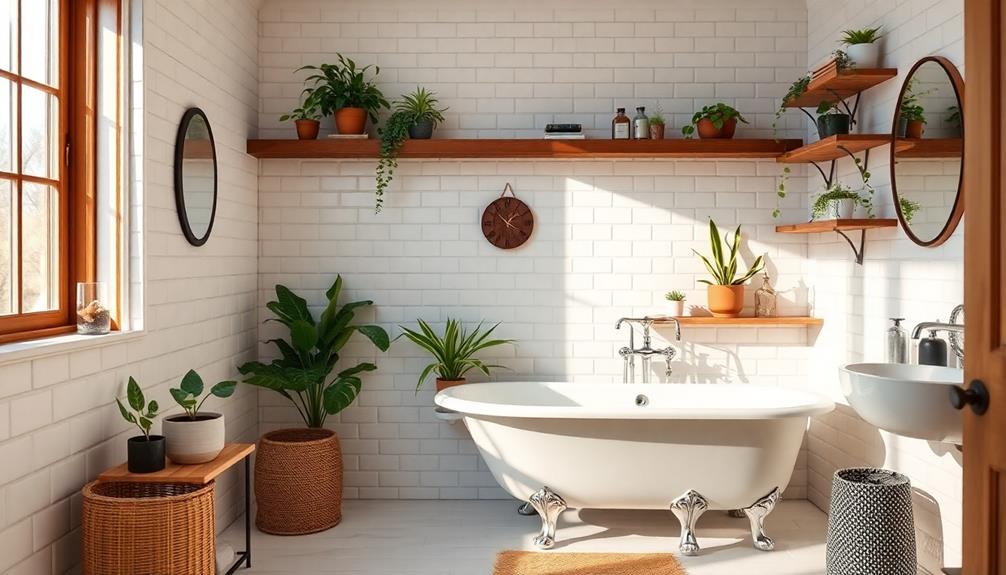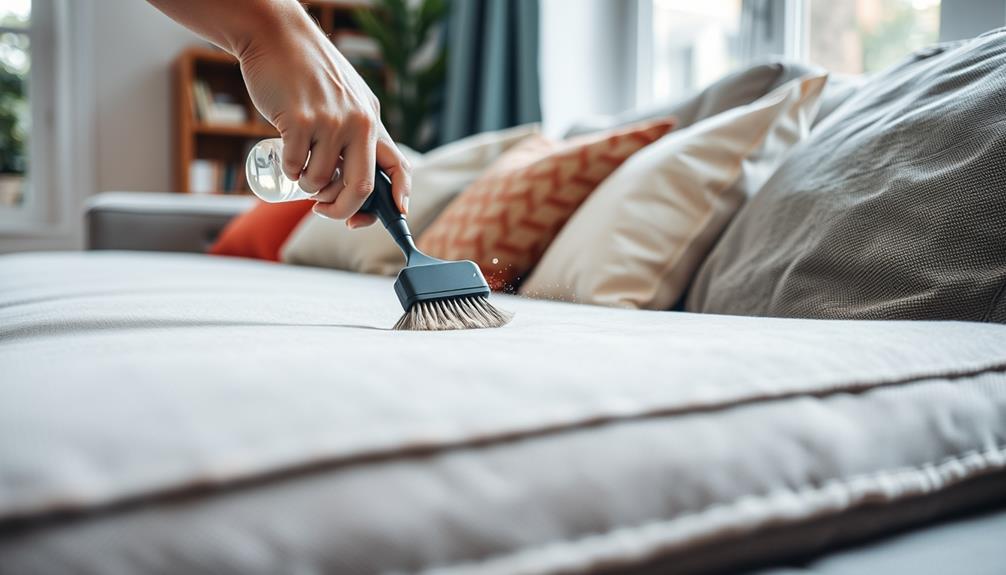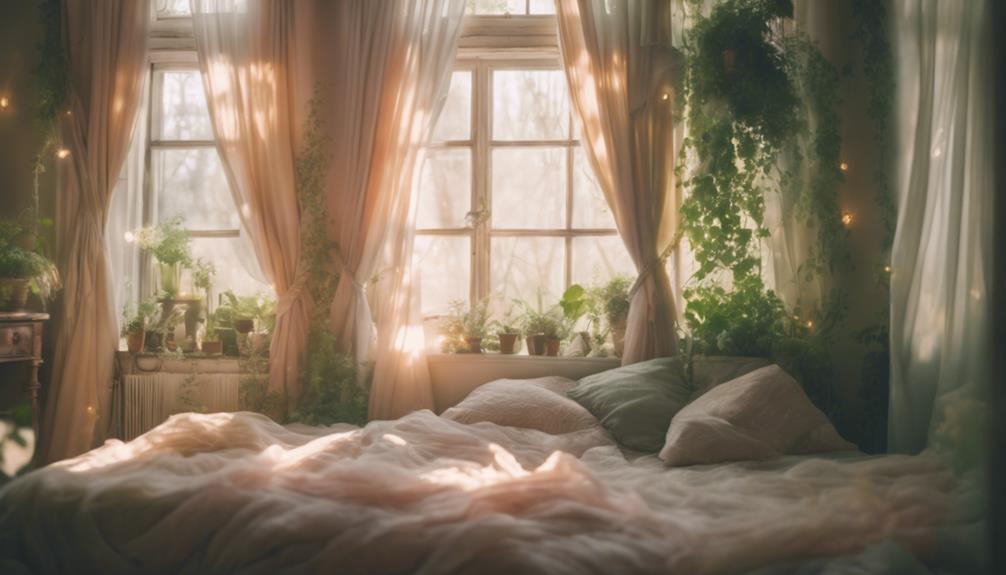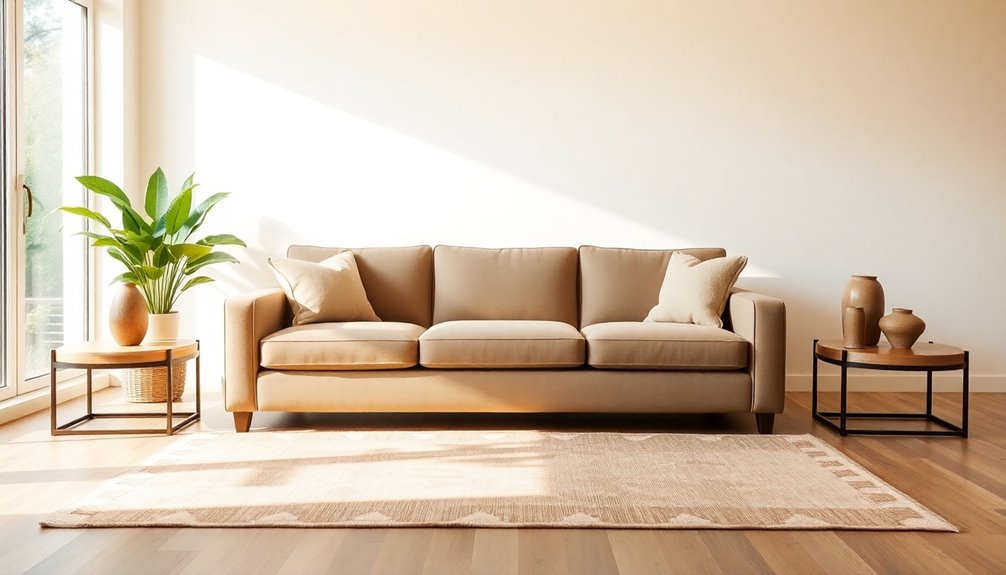When updating your bathroom, make sure to have a solid **budget plan** right from the start. Be sure to include all expenses, such as materials and labor costs, and have a backup fund just in case. Consider taking on some **DIY projects**, like painting or changing hardware, to save money. Instead of replacing everything, focus on **refinishing existing fixtures** for big savings. Stick with the current plumbing setup to avoid pricey changes. Think about making **simple upgrades** like new lighting or a fresh coat of paint to spruce things up. By staying organized, you’ll be able to handle your remodel more efficiently. Learn more tips to elevate your project affordably. When you’re **planning a bathroom remodel**, it’s crucial to prioritize your spending and budget wisely. Invest in quality, durable materials for high-traffic areas like the shower or tub. Shop around for deals and discounts to get the most out of your budget. With careful planning and smart decisions, you can create your dream bathroom without spending a fortune. Keep reading to find out more!
Key Takeaways
- Opt for DIY projects like painting and hardware replacement to significantly cut labor costs by 40%-50%.
- Maintain existing plumbing layouts to save around $5,000 per fixture relocation.
- Consider refinishing fixtures instead of replacement, saving up to 50% on costs.
- Set a clear budget with a contingency fund of 10-20% for unexpected expenses.
- Utilize affordable materials like laminate or vinyl that mimic high-end looks at lower prices.
DIY Bathroom Projects
When it comes to remodeling your bathroom, diving into DIY projects can be a game-changer. By tackling these tasks yourself, you can save money—often reducing bathroom remodel costs by 40%-50% on labor alone. Simple projects like painting the walls or replacing cabinet hardware not only enhance your space but also give you a sense of accomplishment.
Additionally, just like experimenting with different brewing methods can affect the final taste of coffee, exploring various DIY techniques can transform your bathroom in unexpected ways unique aroma in homes.
Consider refinishing existing fixtures instead of replacing them. This cost-effective approach extends the life of items like bathtubs and cabinet doors while minimizing waste. Plus, you'll develop valuable skills that can benefit future remodeling projects. There are countless online resources and tutorials that can guide you through various DIY bathroom upgrades, empowering you to take control of your remodel.
Start with manageable projects to build your confidence. As you gain experience, you'll feel more prepared to tackle more complex tasks. Each small victory can motivate you to continue transforming your bathroom into a space you love. Start by organizing your ideas and creating a clear vision for each step, keeping the bigger picture in mind. You might find spa floor plan inspiration through magazines, online blogs, or even by visiting local showrooms for ideas on how to create a relaxing, serene environment. With careful planning, you can make gradual yet impactful upgrades that align with your budget and style.
Effective Budget Planning
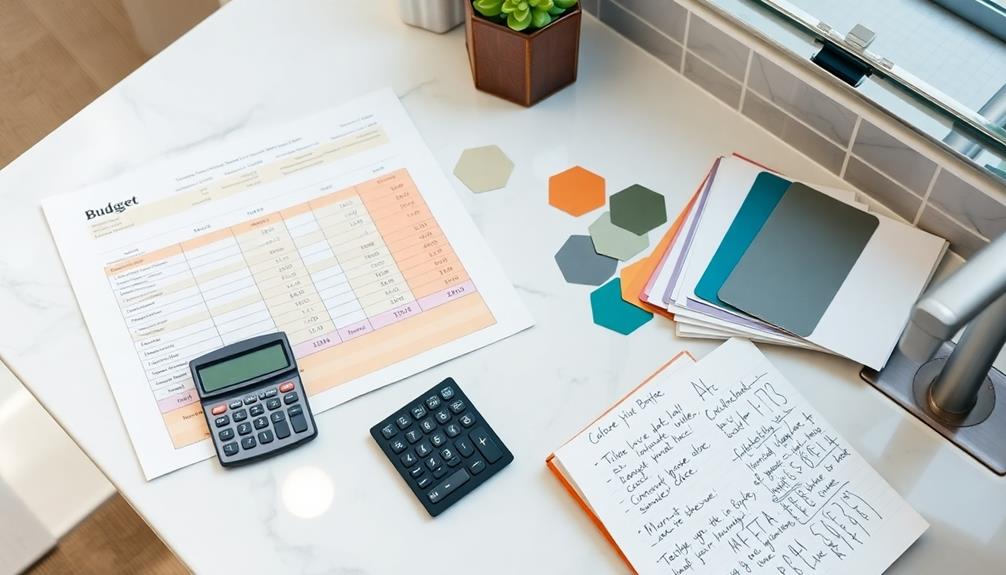
When you start your bathroom remodel, it's vital to establish clear budget goals to keep your spending in check.
Consider implementing a Budget that includes all potential costs, including labor and materials, to avoid overspending.
Prioritize the essential upgrades that will make the most impact and track your expenses regularly to avoid surprises.
This proactive approach helps guarantee your project stays on budget and meets your expectations.
Establish Clear Budget Goals
Setting a clear budget is vital for a successful bathroom remodel. Start by establishing a detailed budget that outlines all anticipated remodeling costs, including materials, labor, and a contingency fund for unexpected expenses.
Remember, projects often exceed initial estimates by 20-30%. To help protect your savings, consider researching potential costs and getting multiple quotes, much like how one should avoid gold IRA scams.
It's important to set specific budget goals for each aspect of your bathroom renovation, like fixtures and flooring. This helps guarantee that spending remains within limits while allowing for adjustments based on actual costs.
Track your expenses using written plans to avoid impulse purchases that can lead to overspending and derail your overall budget.
To save money, research and compare prices from multiple suppliers and contractors. Even small savings on materials can add up appreciably.
Also, prioritize essentials over luxury features to allocate your budget effectively. Focus on updates that enhance functionality and necessary repairs, as these provide the best return on investment.
Prioritize Essential Upgrades
To make the most of your bathroom remodel budget, start by pinpointing essential upgrades that enhance both functionality and aesthetics. Focus on critical issues first, like plumbing leaks or inadequate ventilation. Addressing these problems not only prevents costly repairs later but also guarantees a more efficient remodel.
Additionally, consider creating a mood board to visualize your design concepts, as this can help you prioritize which upgrades will have the most impact.
Once you've tackled the essentials, consider refinishing existing fixtures and cabinetry. This option can save you up to 50% compared to full replacements and still give your bathroom a fresh look.
Alongside refinishing, think about minor cosmetic enhancements, such as painting or updating hardware. These changes can yield a significant visual transformation without breaking the bank.
Don't forget the importance of lighting. Improving lighting can dramatically elevate the overall bathroom experience, making it feel more inviting and spacious.
Establish a clear budget that allocates funds specifically for these essential upgrades, allowing for some flexibility in case unexpected expenses come up.
Track Expenses Regularly
Keeping a close eye on your expenses throughout the bathroom remodel is essential for effective budget planning. By regularly tracking expenses against your budget, you can identify areas of overspending and make timely adjustments. Utilize budgeting tools or apps to categorize your spending, making it easier to monitor materials, labor, and unexpected costs.
Set aside a contingency fund of at least 10-20% of your total budget for those unforeseen expenses that often pop up during remodeling. Periodically compare actual costs against your initial estimates to evaluate if your spending aligns with your remodeling goals. This proactive approach to financial management will help you avoid costly surprises.
Here's a simple way to track your expenses:
| Category | Estimated Cost | Actual Cost |
|---|---|---|
| Materials | $ | $ |
| Labor | $ | $ |
| Unexpected Costs | $ | $ |
| Contingency Fund | $ | $ |
| Total | $ | $ |
Document all receipts and invoices to maintain a clear record of expenditures, assisting you in future home projects.
Optimize Existing Layout
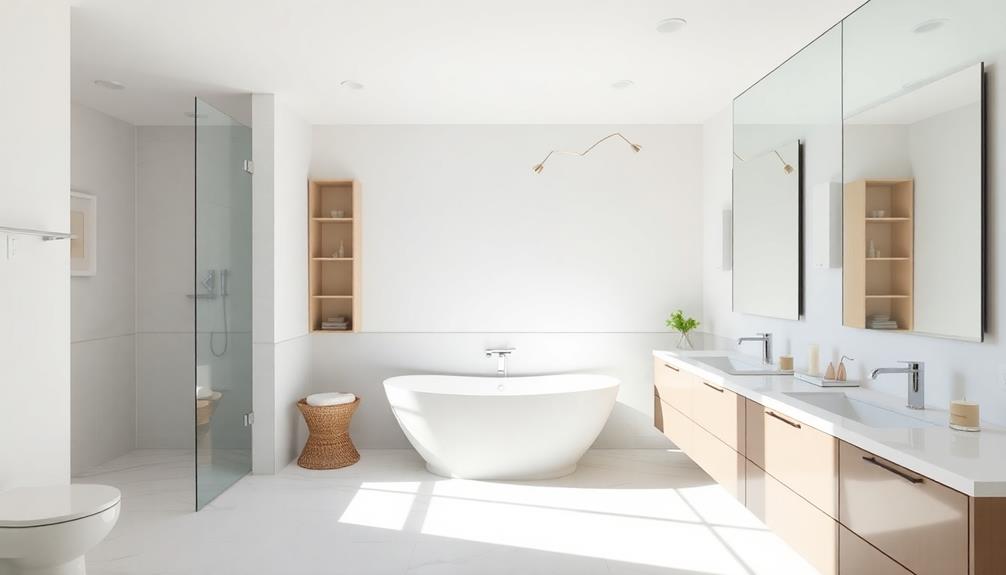
Why change what works? If your bathroom layout already functions well, maintaining the existing plumbing can save you a hefty sum—around $5,000 for each fixture you relocate. By choosing to optimize the layout instead of starting from scratch, you greatly reduce remodeling costs.
Minor adjustments, like using extension pipes, can enhance the space without extensive plumbing changes and help you avoid messing with load-bearing walls.
Additionally, focusing on content relevance and authority allows you to make informed decisions about fixtures and materials that align with your vision while staying within budget. Sticking with the original layout minimizes complications and unexpected expenses that often arise from relocating plumbing and electrical systems.
This way, you can reallocate your budget towards aesthetic upgrades that truly transform your bathroom's look, like stylish fixtures or beautiful tile choices.
Thoughtful product selections that align with your current layout can enhance functionality while keeping expenses manageable, leading to a cost-effective renovation process. By focusing on optimizing what you already have, you not only save money but also create a space that meets your needs without unnecessary hassle.
Consider your existing layout an opportunity to innovate rather than a limitation.
Refinish Instead of Replace
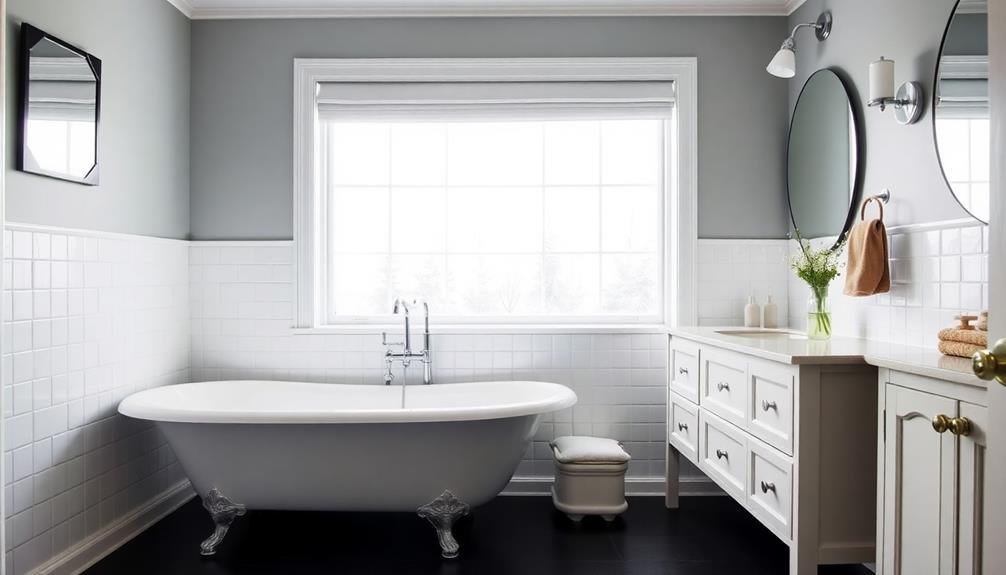
Optimizing your existing layout sets the stage for a smart remodeling decision: refinishing rather than replacing fixtures. By choosing refinishing, you can save money and cut costs considerably.
For instance, refinishing bathtubs and showers typically ranges from $300 to $600, whereas replacements often exceed $2,000. That's a staggering difference that can keep your bathroom remodel budget-friendly.
Additionally, consider how air quality considerations can impact your bathroom environment, making refinishing a more sustainable choice.
You can also update finishes or colors on faucets and hardware, giving your bathroom a fresh look without the hefty price tag of new fixtures.
Using trim kits for faucets and refinishing cabinetry allows you to achieve a cohesive and updated appearance while minimizing waste and expenses.
Simple Cosmetic Upgrades
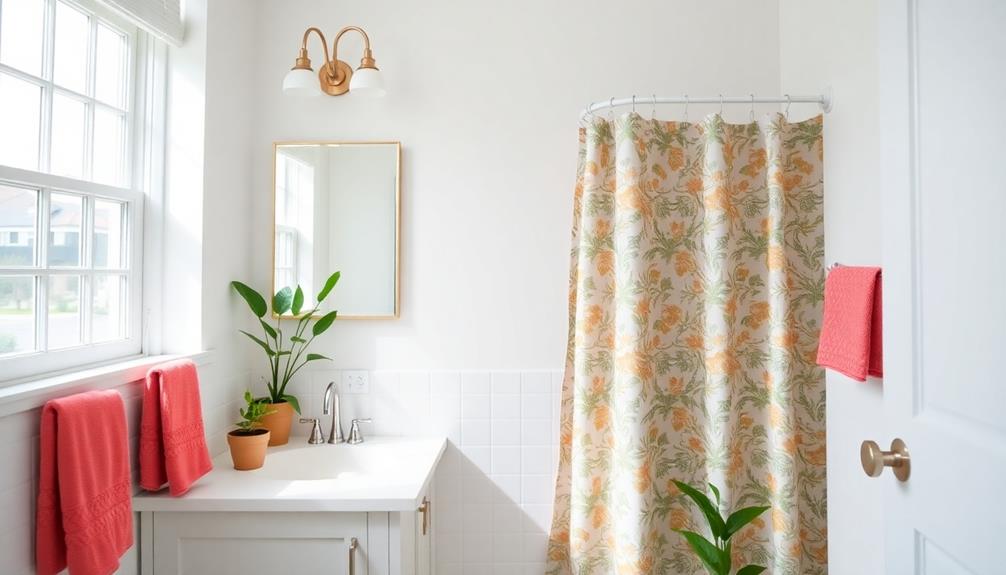
If you're looking to give your bathroom a fresh look without breaking the bank, consider applying a new coat of paint.
A neutral color palette with pops of color can create a serene atmosphere, while pairing that with stylish new cabinet hardware can make a huge difference in the overall vibe.
Incorporating farmhouse bathroom features can enhance the charm of your space.
These simple upgrades can transform your space for a fraction of the cost of a full remodel.
Fresh Paint Application
A fresh coat of paint can work wonders in transforming your bathroom without breaking the bank. It's one of the most cost-effective options in bathroom remodeling, typically costing only $50 to $100 for supplies, compared to thousands for major renovations.
Choosing light colors can make your small bathroom feel larger and brighter, enhancing its overall ambiance without a considerable investment. Additionally, consider incorporating essential oils for sinus congestion relief in your bathroom space, as they can contribute to a soothing atmosphere while you enjoy your refreshed surroundings.
Consider adding an accent wall with bold colors or patterns. This approach adds depth and interest to the space, all without the need for expensive materials or labor.
However, proper preparation is crucial. Cleaning and priming surfaces beforehand guarantees a professional finish and increases the longevity of your paint job, which ultimately helps in saving money on frequent touch-ups.
Don't forget to use moisture-resistant paint. This type of paint enhances durability and protects against mold and mildew, saving you even more on future repairs and maintenance.
Stylish Hardware Replacement
Revamp your bathroom's look with stylish hardware replacements that make a big impact without straining your budget. One of the easiest ways to refresh your space is by replacing cabinet hardware, such as knobs and pulls, which can cost as little as $2 to $10 each. This simple change can dramatically alter the room's appearance.
Additionally, consider incorporating elements from the latest trends in home improvement, such as the use of airless paint sprayers, which can enhance the painting process for your bathroom remodel.
Next, consider modernizing faucets. New designs not only enhance style but also improve function, typically ranging from $50 to $200. The visual impact is substantial without the need for major renovations.
Don't forget about towel bars and toilet paper holders. Swapping these outdated plumbing fixtures for contemporary styles can be done for $10 to $50 each, instantly updating the aesthetic.
Adding a stylish new showerhead can also elevate your bathing experience, with prices from $20 to $150. It offers both functional benefits and visual enhancement without extensive labor.
For a polished look, coordinate finishes across all hardware—think matte black, brushed nickel, or chrome. You'll find many stylish options available at budget-friendly prices, ensuring your bathroom remodel remains cost-effective while looking chic.
Essential Cost-Cutting Strategies
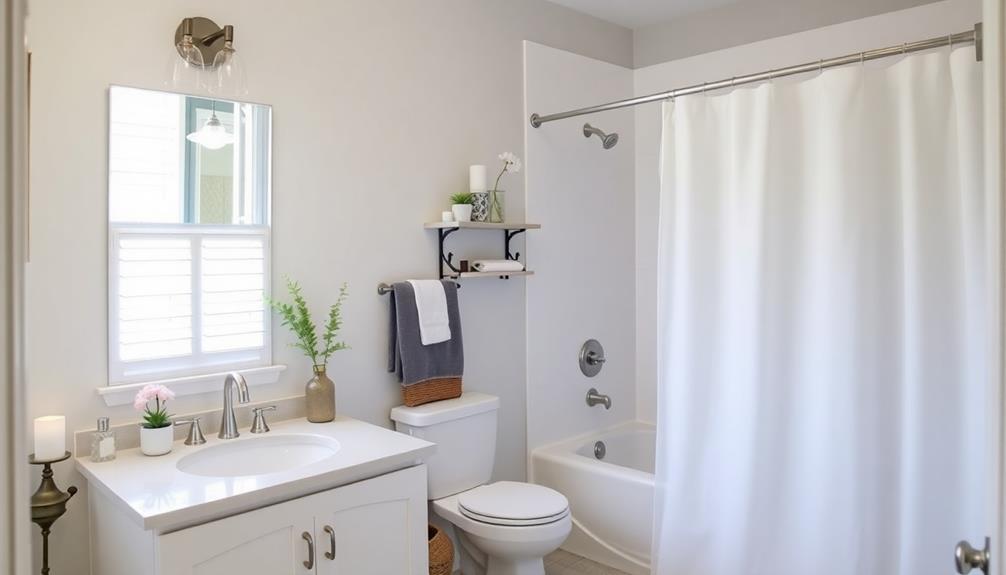
Budgeting for a bathroom remodel can feel overwhelming, but smart strategies can help you cut costs without sacrificing style.
First, consider maintaining your existing plumbing layout. This simple move can save you about $5,000 per fixture by avoiding the expensive relocation work during renovations. Additionally, opting for energy-efficient appliances in your bathroom, such as smart faucets and lighting, can contribute to long-term savings on utility bills, which is important for overall household budgeting. Energy-efficient appliances can lower overall energy consumption.
Next, opt for affordable materials like laminate or vinyl to mimic high-end looks while considerably reducing costs.
Refinishing your existing fixtures, such as tubs and cabinets, can be up to 50% cheaper than replacement, providing a cost-effective way to refresh your space. Additionally, simple upgrades like replacing cabinet hardware or sink faucets can deliver dramatic visual impacts without extensive remodeling.
Don't underestimate the power of DIY approaches. Tackling tasks like painting or installing light fixtures yourself can save you 40%-50% on labor costs, allowing for greater flexibility in your budget allocation.
Safety and Compliance Tips
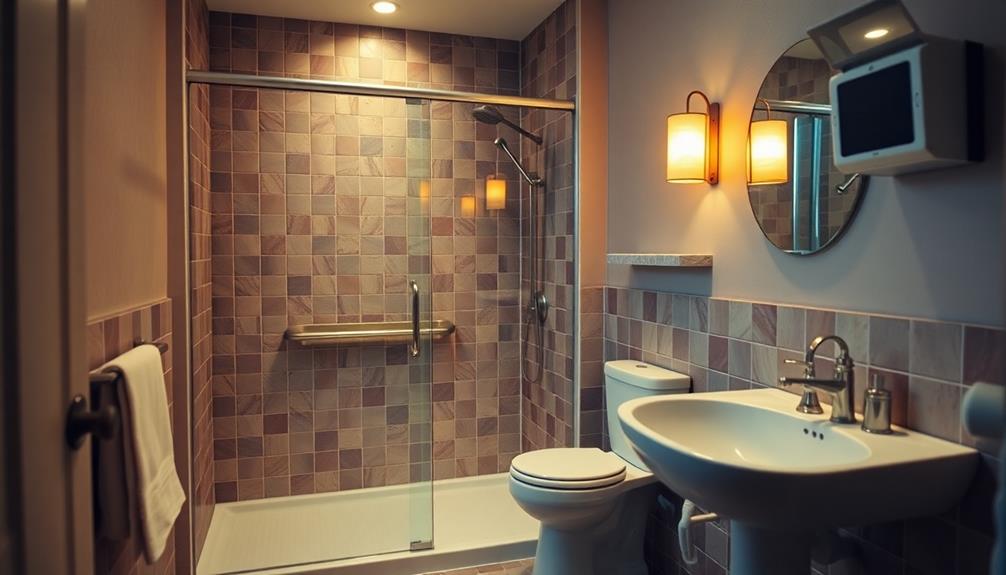
Before diving into your bathroom remodel, it's crucial to guarantee safety and compliance with local regulations. Remember that skipping permits can lead to fines or the need to redo work that doesn't adhere to local building codes.
Familiarizing yourself with these codes guarantees your renovations are up to standard and avoids potential legal headaches down the line. Understanding the importance of proper planning can help you navigate challenges, similar to navigating divorce complexities.
Here are some key safety and compliance tips to keep in mind:
- Always obtain necessary permits before starting any work.
- Familiarize yourself with local building codes to meet safety standards.
- Use protective gear like goggles and gloves to prevent injuries.
- Install smoke and carbon monoxide detectors in the bathroom area.
- Consider hiring a pro for complex tasks like electrical or plumbing work.
Taking these steps not only enhances safety but also helps you avoid costly mistakes.
When in doubt, hiring a professional is a smart move, especially for tasks that require specialized knowledge. Prioritizing safety and compliance will pave the way for a smoother remodeling experience, letting you focus on creating the bathroom of your dreams without worrying about legal issues or safety hazards.
Smart Technology Options
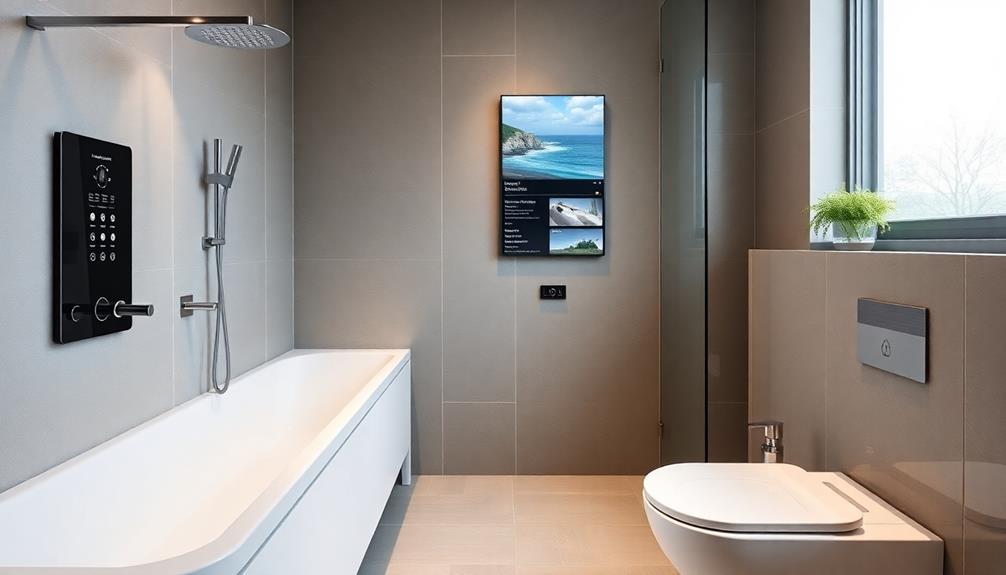
Incorporating smart technology into your bathroom remodel can transform the space into a modern, efficient oasis. By installing smart faucets with touchless technology, you can conserve water usage, cutting your bills by up to 30% compared to traditional faucets. This small change can make a big impact on both your budget and the environment.
Smart lighting systems, including LED bulbs with dimmers, allow you to customize your bathroom's ambiance while reducing electricity costs. You can enjoy energy-efficient lighting that suits your mood and needs.
Pair this with smart thermostats, which can manage heating efficiently, potentially lowering your energy costs by 10-15%.
Don't overlook smart exhaust fans equipped with humidity sensors. These devices help maintain air quality and prevent moisture-related damage, saving you from costly repairs down the line.
Additionally, consider investing in smart mirrors that come with built-in LED lighting and defogging features. They not only enhance your daily routines but also provide energy-efficient lighting solutions, minimizing the need for additional fixtures.
Frequently Asked Questions
How to Reduce Costs on a Bathroom Remodel?
To reduce costs on a bathroom remodel, keep your existing plumbing layout, choose budget-friendly materials, refinish fixtures, tackle simple DIY tasks, and shop at used material stores for discounted supplies. You'll save considerably!
What Is the Most Expensive Part of a Bathroom Remodel?
When you begin a bathroom remodel, like Daedalus crafting his labyrinth, remember that labor costs often dominate the budget. Plumbing and electrical work can consume 40% to 60% of your total expenses, so plan wisely.
How Much Should You Spend on a Bathroom Remodel?
You should aim to spend between $10,000 and $30,000 on a bathroom remodel, depending on your goals and preferences. Consider your home's value and your budget to determine what's reasonable for your project.
How to Save on a Bathroom Makeover?
To save on a bathroom makeover, keep your plumbing layout intact, refinish existing fixtures, choose budget-friendly materials, add simple cosmetic updates, and tackle DIY projects to minimize costs while achieving a stunning transformation.
Conclusion
By embracing these cost-saving strategies, you can turn your bathroom remodel dreams into reality without breaking the bank. Think of your budget as a sturdy ship; with careful planning, it'll sail smoothly through the waves of renovation. Remember, each small change—like a drop of paint or a polished fixture—can create a ripple effect, transforming your space into a serene oasis. So roll up your sleeves and get ready to make your bathroom shine while keeping your wallet happy!
